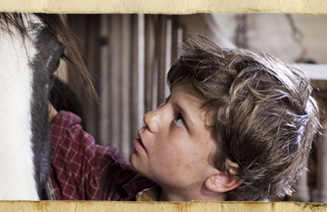In this clip, we see the children attempting to crack a whip. The use of whips reflected an economy that was highly dependent on animal labour, such as herding cattle, and driving horses and carts. However, in the early 19th century whips were also used as a common form of punishment against people.
Discover
- As a class, discuss different ways whips were used in Davey's time. Ask students to research the use of whips in the 19th century. To help focus their research, ask students the following questions:
- What were whips used for in Davey's time and why were they important?
- How were whips made?
- Were different types of whips used? If so, name some different types of whips.
- Do people still use whips today? If so, what are they used for?
- Have laws changed about the way we can use whips today?
- The following websites may be useful:
-
Convict Trail, 'Common Misdemeanours and Punishments', http://www.convicttrail.org/history.php?id=a3b3c3%t%4
-
Fremantle Prison, 'Crime and Punishment', http://www.fremantleprison.com.au/History/theconvictera/crimeandpunishment/Pages/default.aspx
-
The National Centre for History Education, 'Crime and Punishment: Convicts and Port Arthur', http://www.hyperhistory.org/index.php?option=displaypage&Itemid=569&op=page#tra
-
State Library of New South Wales, http://www.sl.nsw.gov.au/discover_collections/history_nation/justice/index.html
- Ask students to research how and why the whip produces a 'cracking sound'. Have students draw and label the parts of a whip and describe how it vibrates through air to make a noise.
Reflect
- Ask students to write a letter to a local 19th-century newspaper voicing their opinion about the use of whips against animals and people. Their article should reflect upon the following questions:
- Should whips be used on people?
- Should whips be used on animals?
- Is there an appropriate time to use whips?
- What are the benefits and disadvantages of using whips?
Download
Student Activity Sheet H18.1: Whips



![Horsewhipping [Episode 18 | 1838 : Davey] Horsewhipping [Episode 18 | 1838 : Davey]](/assets/interface/images/spec_graphic/clip/1838/1/thumb.jpg)
![The bushranger [Episode 18 | 1838 : Davey] The bushranger [Episode 18 | 1838 : Davey]](/assets/interface/images/spec_graphic/clip/1838/2/thumb.jpg)
![The shooting [Episode 18 | 1838 : Davey] The shooting [Episode 18 | 1838 : Davey]](/assets/interface/images/spec_graphic/clip/1838/3/thumb.jpg)


